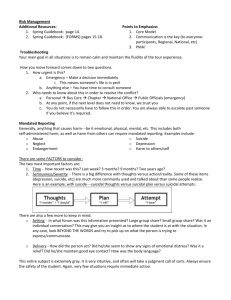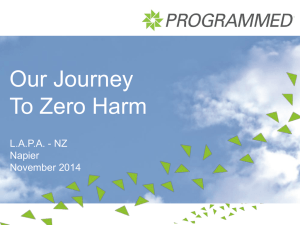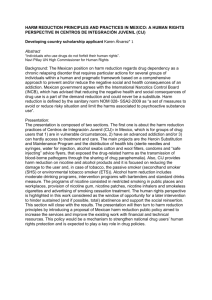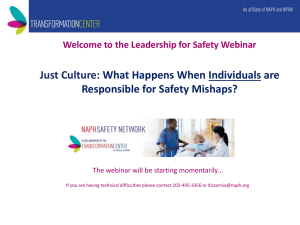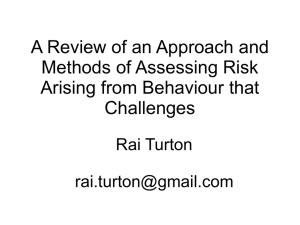Harm Reduction in a 12-Step World
advertisement
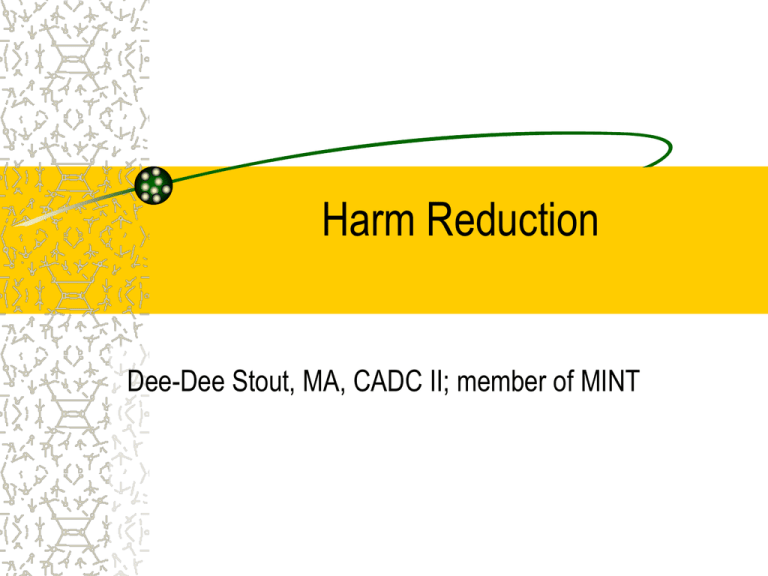
Harm Reduction Dee-Dee Stout, MA, CADC II; member of MINT “Our job is not to talk clients out of the woods but to help clients talk themselves out of the woods.” Bill Miller, 2007 Author, Motivational Interviewing What is Harm Reduction? Relativistic not absolutist A Menu of Options that includes abstinence Integrates: – Appreciation of the meaning of the dx for each person: context – Understands the chemical action & effects on each person: empathy What is Harm Reduction? Harm Reduction is a set of strategies that encourage drug users and others, and service providers to reduce the harm done by licit and illicit drugs (and behaviors). In supporting drug users in gaining access to the tools to improve their healthier & lifestyles, we recognize their competency to protect and help themselves, their loved ones and their communities. HRC Harm Reduction Drug use exists on a continuum – Non-problematic to chaotic Does not focus on drug use but on the harms associated with it ( including behaviors) Principles of HR HR is any action that attempts to reduce the harm of a behavior People use drugs for reasons & not all drug use is abuse - or dependency People can – and do – make rational decisions about important life issues while under the influence of all sorts of things THE STAGES OF CHANGE (Prochaska, DiClemente, Norcross) Precontemplation Contemplation Preparation Action Maintenance Termination Relapse/Recycle NORMAL RESPONSES! Principles of HR Denial is typically a product of shame & punitive sanctions (encourages lying not truth-telling) Ambivalence and resistance to change are natural, not pathological Addiction is a relationship. Tx must offer the same support or respect that it can’t Principles of HR Success defined as “any positive change” – Obstacles are poverty, mental illness, racism, other trauma leading to: hopelessness, despair, self-destruction, self-defeating behaviors, abuse of others, & more – Relationships, self-esteem, and self-care are needed to increase motivation for change – Change is slow, incremental and has setbacks Setbacks (relapse) are the rule not the exception! Drug, Set, Setting* Drug – Substance; cut; route of administration; legality Set – Physiology; psychology; culture; expectations; motivation Setting – Environment; w/whom & where; attitudes to use *Zinberg, N. (1984) Drug, Set, Setting: The Basis for Controlled Intoxicant Use. New Haven: Yale University. Some Goals of HR Save lives Safer drug use Reduced drug use Abstinence Improved emotional state Improved health & relation w/healthcare system Better nutrition More stable income Better social relationships Reduction in isolation Increase support system Increased normalization Risk reductions (HCV, HIV) Better living environment Some Other Goals of HR More intact, better functioning families Reduction in violence & aggression Less criminal activity Greater ability to love and be loved Higher self-esteem, reduction in stigma Any Positive Change! How do you practice HR? Start where the client “is” – Assess the extent & meaning of dx use for client – Desired goals – Level of ambivalence re: change(s) Share expertise with client in this process ONLY with permission! – Help client decide best choice for her drug use/beh change – Be flexible with goals and method of achieving them Assist client implement their Change Plan – Realize relapse is expected part of change process Appreciate & understand - not overcome – resistance Basic Clinical HRP Strategies* Motivational Interviewing Stages of Change Drug, Set, Setting Multidisciplinary Assessment Profile (MAP) – – – – Addiction severity Co-occuring D/Os Support systems Hierarchy of Needs Setting Goals/Plans (when ready) Accurate psycho-ed Coping skills Stress reduction Nutrition SUM RP Family therapy Psych meds Dx substitution: Methadone, LAAM, MJ, etc. Engagement & Retention *from Patt Denning, PhD, Practicing Strategies Harm Reduction Psychotherapy, 2002 16 3 Simple Ways to Use HR to Improve Motivation Flexible goals Mutual methods Be respectful, accurately empathetic, and genuine! Thanks to Scott D. Miller, PhD, for these. For more, go to www.talkingcure.com How do I know I’m using HR? I see consumers as human beings, not case studies I don’t take consumers’ behavior personally I am willing to question myself (& the agency) I am not in pain and conflict; the consumer is I know I am not a plumber – so I don’t try to fix How do I know I’m using HR? I focus on building trusting relationships I realize that consumers know their own needs I listen, and listen, and listen some more I remember that the consumer’s timetable won’t always be mine or the agency’s – but maybe! I am able to explain decisions and all consequences without sarcasm or attitude How do I know I’m using HR? I have oodles of patience I think of ways I can support baby steps – “out of the box” I see the strengths in each person, not just their troubles I am an advocate and a guide, not a healer or a fixer Some Things to Consider Who sets the goals? Are consumers’ priorities accepted? How & is power reasonably balanced? What are menu of options? Who decides what change is needed? In what timeframe? Do you actively seek consumer feedback? Is it used? Who makes the rules? Who is seen as competent? Who does the work of the intervention? How is drug use viewed? Some Things to Consider Who is on the governing board? Who designed the interventions? Is the intervention and staff non-judgmental? How are complaints addressed? Who meets with funders? Presents at conferences? Is the intervention consumerfriendly? How are consumers treated? Do consumers participate in evaluations (not just as respondents)? Who provides services in the agency? As Harm Reductionists, we examine: How we treat each other How our agency treats workers How we treat other agencies Our spirit of coalition building - or are we using competition, greed, & jealousy? How we deal with workers who use drugs How we deal with workers who don’t use drugs The Tyranny of PC Our ability to admit mistakes, apologize, & be open to feedback As Harm Reductionists, we examine: Our honesty Our dishonesty Our working in a Spirit of love and oneness – or ego Our compassion for ourselves Our compassion with others, esp. those who don’t understand – or want to understand - HR HARM REDUCTION Helping Advocating Reducing recidivism Mending wounds HARM REDUCTION Reinforcing healthier options Educating (accurately & w/permission) Delivering hope Uncovering challenges Celebrating choice Treatment opportunities Investing your time Offering support & Never, ever giving up on a consumer! Worker Stances for CD Clients* Show unconditional regard & caring to the client Be a real person: blank screens are for films! Don’t get caught in a client’s urgency Be a constant Be non-judgmental re: the client’s behaviors Worker Stances for CD Clients* Empower! Work through your definition of enabling You’re not responsible to rescue a client; you’re responsible for a process of intervention – The outcome is theirs Set limits firmly but not sadistically – Set the same limits w/client consistently – Reduce “No’s” to essentials – Don’t try to control clients • Try to control yourself instead Worker Stances for CD Clients* Don’t take away defenses until the client has replacements (esp. with trauma/PTSD) Don’t be a drug expert if you’re not – ask your client Explore your own biases about drug use – don’t believe everything your head says Avoid pushing abstinence – let the client be the guide Worker Stances for CD Clients* Positive reinforcement is more successful than negative: reward works better than punishment; use incentives (CM) Get supervision or consultation: counter-transference happens; work with it not against it. Your client is the expert not you; you are a service provider to them. Be humble. Don’t be parental; don’t nag – we all have someone to do that already! *Thanks to Edith Springer, NYC Pioneer in HR



